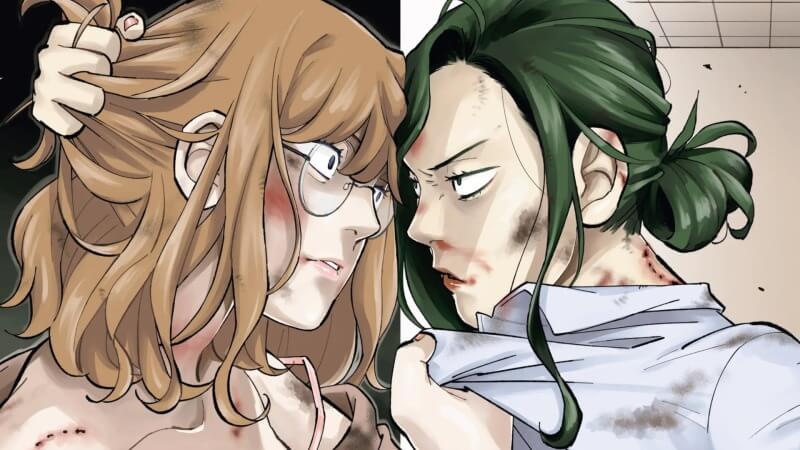In ‘Toxic Yuri’ Manga Black and White, A Co-Worker’s Fist Feels Like A Kiss

Capitalism makes charlatans of us all. Sentimentality has no place in a numbers-driven workplace. It’s a squared circle of performative gestures, a hierarchy of status which dominates one’s needs. Sincerity will get you killed; ambition can get you brushed aside by someone smarter, younger, better. Perhaps the most ruthless part of it all is that we accept this violence as normal—the operative way our livelihood and economy should be managed.
Black and White: Tough Love At The Office is a yuri manga from Sal Jiang that exaggerates and amplifies this psychological brutality into psycho-sexual angst. Jitsugyo no Nihon Sha serialized it online via Comic Ruelle, before releasing it over three tankōbon volumes; Seven Seas collected these into a single English omnibus this past summer, released through their Girls’ Love imprint simply as Tough Love At The Office.
But protagonists Junko Shirakawa and Kayo Kuroda do not love each other. At least, not in the traditional sense. From the first of 18 chapters on, their simultaneous fixation on and loathing of one another is palpable. Both women work in the cutthroat world of corporate banking, managing large sums of money, investment portfolios, and the like. Kuroda is a transfer from sales, and Shirakawa is tasked with training and catching her up to speed.
The latter’s resentment is immediate. Shirakawa is driven by an insecurity that Kuroda will succeed over her; that the pretty, likable woman from sales is more valuable than she is. It’s imposter syndrome—even as her superior, Shirakawa worries that Kuroda is more capable and ready to take her spot. She begins to meddle in Kuroda’s work—reading over her shoulder and rifling through papers. But this makes Shirakawa’s work sloppier. Due to this obsessive spiral, she fails to do a background check on a potential client and gets reprimanded by their Deputy Director.
This is where the manga kicks into overdrive. Left alone to correct their mistakes, the women’s animosity burbles over. Kuroda calls out Shirakawa for her snooping and micromanaging. In kind, she’s met with a fist to the face. Shirakawa punches a seated Kuroda in the manga’s first, full-page physical strike. But her kohai doesn’t move from her spot. She takes the blow, then lunges forward, grabs Shirakawa by the blouse, and forces their lips together.
So begins Black and White’s main loop. Jiang’s narrative breaks her plot into terse cycles of escalation, in which tensions simmer until they roil over and explode into impact play sessions. Kuroda and Shirakawa undermine each other for a period—interfering in each other’s professional and personal lives—then beat each other black and blue as they gnash their lips and tear at each other’s clothing. Shirakawa’s seniority is questioned when Kuroda deliberately allows her to make mistakes and be reprimanded for it. Kuroda’s past flame from another branch becomes a prime target for Shirakawa to throw under the bus. Nothing is off limits for either woman—everything and everyone are pieces on the board in their game.
Jiang’s artwork is economical and high impact. Her line work is thick and well-defined, which not only gives each character a distinct silhouette, but allows for the bare knuckle brawls to hit even harder. Soft, fatty flesh on stomachs, breasts, and faces are given more ink to bend as fists and feet are driven into each woman. It’s art that is as in love with the feminine form as it is bruising, battering, and blooding it via knock-down, drag-out erotic brawls; in that sense, there’s a kinship with more “realistic” erotic artists like Psycho (Hanbun Omocha, Billion Fight.) The more grounded proportions and mature characters evoke josei, too, more than the average yuri story—a shadow side to the more grounded romance among thirtysomethings in a series like Even Though We’re Adults.
Black and White is also unique from contemporary manga built around violent sapphic eroticism—such as Booty Royale—in its lack of classical fan service. Jiang’s illustrations are erotic without glistening, balloon-like breasts or pert, bouncy butts often associated with contemporary erotic manga aesthetics. Instead, sensuality is derived from the small details—each ridge of Shirakawa’s toes, for instance, as she tramples a bound Kuroda’s cheeks. The reader can practically soak in the scent of each digit, feel the soft, clammy flesh press down on their cheekbones. It’s a more complex type of sexual desire—a yearning built from power dynamics and the desire to be touched by the untouchable. This is not love—it’s something deeper, more primal, and far nastier.
Erica Friedman puts it well in her review:
[…] Sex they have is full on power performance. This is not a pretty book about an office romance. This is a violent story about two terrible people being terrible to one another […] The characters are terrible people, but they sometimes do good or kind things, which gives them nuance. Neither of them is a sadist to the pleasant office drones around them. They are, however, two dominant humans fighting for dominance in every way possible.






































